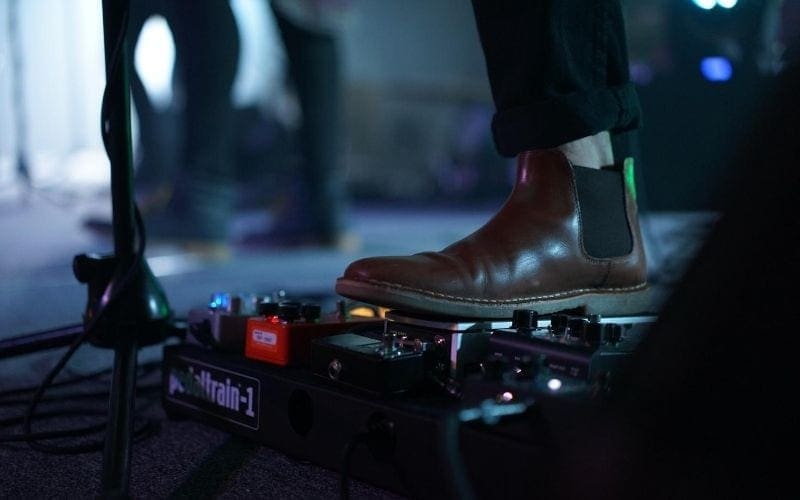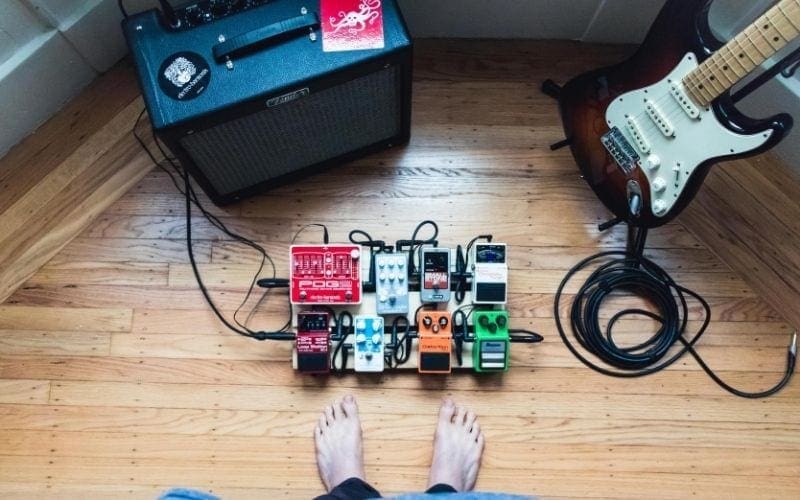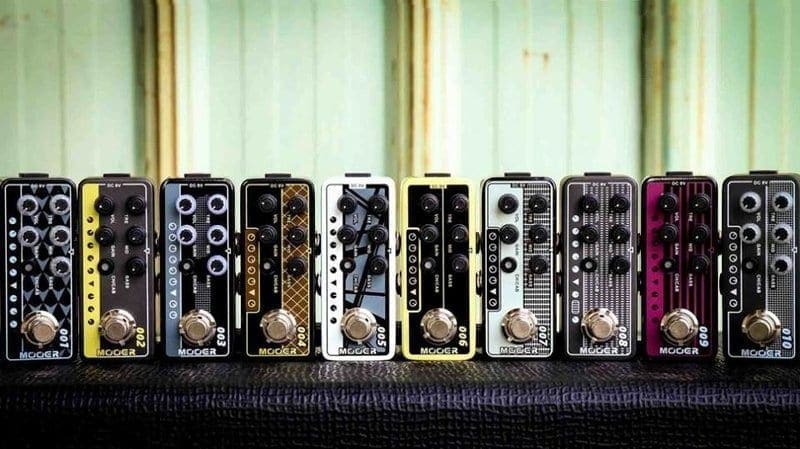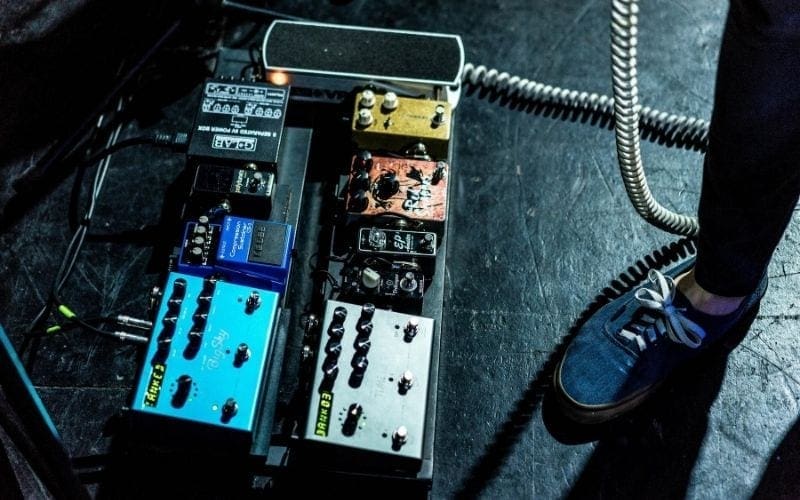Let’s paint a picture…One of the consequences of the coronavirus lockdown has been an increased, and possibly final, swing away from high street retailers to online shopping. You can buy almost anything online, from groceries to human souls. And with increased time on our hands, there has inevitably been an increase in frivolous guitar pedal purchases from online stores. In my case, those purchases have taken a very specific shape: effects pedals.

Up until relatively recently, I harbored the illusion that I could somehow ‘complete’ my pedal board setup. There was a specific list of pedals that I wanted, and once I had those, there would be no need to purchase any more. However, I was thinking about guitar pedals in precisely the wrong way. Guitar pedals are like colors on a palette. It’s probably impossible to assemble a palette containing every color, especially when people keep inventing blacker blacks. And a palette is only useful if it contains the colors required for the job at hand. If you only paint in black and white, your palette is pretty simple to assemble. But if you paint in glorious technicolor, you’ll need a bigger palette.
With that in mind, I have no intention of providing some sort of definitive guide to assembling a pedal board. Nor do I want to talk about ‘must have’ guitar pedals. The fact is, something is only essential if you need it, and every guitarist’s needs, not to mention their tastes, are fairly unique. Instead, consider what I say below as something like an attempt to describe a pretty versatile palette – one that should capture a lot of the common uses guitarists have for guitar pedals. So, where do we begin?
The Foundations

Do you need a pedalboard? Some guitarists may not need a pedalboard at all because the only pedal they need is distortion. Some guitarists, by contrast, might need more than one pedalboard: perhaps one for bass, one for electric guitar, one for acoustic, and so on. Whatever your preference on how to set up guitar pedals,there ise a range of pedalboards out there that will likely suit you.
Pedaltrain, for example, has a range of size options, allowing you to fit anything from a small handful of pedals to a rig with some of the larger loopers and MIDI controllers that are available. These come with either soft or hard cases, so it doesn’t matter whether you’re gently putting your pedals into the back of your car or a crew member is carelessly throwing it in the back of the splitter van, there should be an option suitable for keeping your pedal collection safe.
What I particularly like about Pedaltrain’s boards is that they have a range of accessories that are designed to fit their boards perfectly. In particular, I’m a big fan of their Volto power supply, which is a 9V power supply that can be charged via USB and used to power pretty much any set of pedals (via the included daisy chain cables) without the need for a mains socket. This has proven to be useful for some of the artists I manage when on tour since it can be charged in the tour van, and means they don’t have to rely upon the venue having plug sockets in useful places on the stage. The Volto fits neatly on the underside of your pedalboard, so doesn’t occupy any of its valuable real estate.
Do I Need To Spend Big To Sound Big?
Before moving onto specific pedals, it’s worth saying something about budget. New guitar pedals range from as little as £20 up to several hundred pounds, depending on the brand and type of pedal. It’s not an unreasonable general assumption to think that you get what you pay for. And, in the guitar pedal world, there is a certain degree of snobbishness that frequently sees people dismiss particular brands of pedal entirely and overvalue others. In reality, the huge price difference between pedals comes largely down to the manufacturing processes involved.
Boutique Effects Pedals
Some pedal companies, like JHS and Earthquaker Devices, are described as ‘boutique pedal’ companies because their pedals are hand-made by a relatively small team of people – sometimes it’s even just one person who makes every single pedal. Other companies, like Boss and Behringer, are enormous companies with huge assembly lines in factories in China. This allows them to benefit from cheaper labor and economies of scale, meaning their pedals (generally) have a much lower retail price.
So, is JHS pedals better than Behringer ones? Well, consider again the analogy I set out above: pedals are colors on a palette. So, to some extent, it’s like asking if orange is better than purple. However, both companies make the same kinds of pedal – reverb, chorus, delay, etc. – so perhaps it’s fairer to say it’s like asking if this yellow is nicer than that one. And this is subjective. But there will likely be general agreement in a certain direction, and usually in favor of pricier brands like JHS. Yet, JHS buy many of their pedals’ components from Behringer, so this judgment isn’t entirely down to build quality.
Moreover, the aim of JHS pedals and the aim of Behringer is quite different. JHS began as one person’s attempt to modify (‘mod’) existing Boss pedals to get a particular kind of sound, and developed into creating entirely new pedals. Behringer, by contrast, primarily tries to clone existing popular pedals and offer them at a lower price. So, they’re aiming for different sounds. Are Behringer’s pedals as good as the ones they’re trying to clone? The answer is: sometimes! The founder of JHS pedals himself posted a video on YouTube demonstrating as much, and you can hear the comparisons for yourself.
Guitar Effects Pedals
Before you start splashing out on fancy effects, really the first guitar pedal you should buy is a tuner! A tuning pedal does the obvious – it helps you tune your guitar. But it can do so without you – and, more importantly, your audience – having to be able to hear it. The tuner I use is the TC Electronic Polytune 3: it’s small, so leaves room for pedals that are a lot more fun!
Chronologically speaking, the first real effects pedal you buy will simply depend on the kind of effect you need. If your amp doesn’t have reverb, you’ll likely want a reverb pedal as a priority. If you’re a bassist and you’ve suddenly found yourself filling in for Chris Wolstenholme in Muse, you’re probably going to need to pick up a Big Muff and/or a bass synth pedal. But in another sense, the first thing any guitarist encounters is a pre-amp.
Pre-Amp

‘Pre-amp’ is short for ‘pre-amplifier’. Every guitar and bass amp I’ve ever seen has one built-in. The role of the pre-amp is to amplify the (voltage gain) signal from your guitar before sending it to a second, ‘power’, amplifier, which amplifies the new (current gain) signal so that it moves the speaker and generates audible sound. Importantly, pre-amps have an EQ section, which allows you to sculpt the sound that ultimately comes out.
Given that guitar and bass amps already have a pre-amp, then it might seem surprising that you can also buy pre-amp pedals… effectively meaning that you’re adding a pre-amp to the signal chain ahead of the one that comes with the amp. But if you remember the ‘colors on a palette analogy’ then it makes sense that you might want to further sculpt that sound using such a pedal.
Signal Chain
A pre-amp pedal is therefore likely to be the first thing in the signal chain on your pedal board since the signal that comes out is clean, sculpted (using the pedal’s EQ), a signal that can then be subsequently driven or distorted (or you can add reverb to it, or delay, or both… and so on). What comes after that will depend on what sort of effect you want to apply to that signal.
It’s also worth noting (and thanks to my newest artist Sailmaker for pointing this out) that because your pedals are running into the pre-amp that comes with your guitar/bass amp, the amp itself can impact the sound of your guitar pedals – so some amps might not be a good fit with some pedals. In any case, JHS, who I mentioned earlier, makes one of the best pre-amp pedals around. It is based on the Boss FA-1 pedal (used by The Edge from U2), but offers a more versatile range of EQ options, allowing you to sculpt a more diverse range of sounds. So, check out the JHS Clover, if you think you have any need for a pre-amp pedal.
Reverb Effects Pedals
One of the most common effects used in music – whether it’s on guitar, vocals, piano, or whatever – is reverb. Essentially, reverb pedals aim to mimic the sound of the natural acoustics of a room. When you play an instrument or sing in a given room, it takes a little while for the sound to reach the walls, ceiling, and floor of that room, and then bounce back.
This creates a slight delay between the original sound and the reflected one. These reflections, or reverberations, build up alongside the original signal and create the ‘reverb’ effect. If the original signal stops dead, it will still be possible to hear the reverberations from this signal for a time afterwards, and this is what a reverb pedal adds to your sound.
There are lots of different kinds of reverb, and it isn’t possible to go into depth on these here. Reverb pedals have been around since the 1980s, and most attempt to mimic the sound of specific sorts of rooms – halls, chambers, etc. Some pedals add different features allowing you to modify the (artificially) reverberated sound, creating some pretty cool textures that can sit under your guitar sound. I use the Strymon Blue Sky reverb pedal, which offers the capacity to create a vast range of ambient sounds, as shown in the video below.
Distortion Effects Pedals
Another kind of pedal mentioned above is the distortion pedal. Most guitarists need one, whether playing blues, metal, or anything in between. Essentially, distortion pedals attempt to mimic the natural effect that occurs when a signal becomes too loud for an audio device to handle, which distorts the waveform of the signal. There are lots of different kinds of distortion effects pedals which essentially try to offer this same outcome but without having to drive up the volume, which they do by ‘clipping’ the audio signal.
There are different ways in which this effect can be achieved, and therefore there are different kinds of distortion pedals available that try to capture those different methods for distorting a signal. As such, it may be an overdrive or a fuzz pedal (such as the Big Muff bass pedal mentioned earlier) that you need to look out for, rather than a distortion pedal, per se. However, we can’t get into the subtleties of these distinctions here.

Distortion Effects Pedals Recommendations
So which distortion pedals are worth taking a look at? Again, this is going to be subjective and based on the kind of music you’re making. A blues guitarist is likely to want to seek out an overdrive pedal, such as the Boss BD-2 (or the slightly pricier Waza Craft mod of this pedal). If you’re in a metal band, there’s the Boss MT-2 (and it’s Waza Craft mod). These pedals differ in the way and the amount that they distort the signal from the guitar, so sound very different from one another.
For a versatile distortion, you might want to go for a classic like the Boss DS-1 or the Proco RAT. Both are widely used, heard on tons of records, and relatively inexpensive. Slightly more expensive, but just as widely used, is the Ibanez TS9 tube screamer, which comes in a couple of variations. You can hear the differences between these versions, and the TS808 vintage tube screamer, in the video below.
Read more about distortion pedals, how they work, and some more recommendations in this guide to distortion pedals.
Delay Effects Pedals
Delay pedals work by recording the signal from the guitar and then playing it back shortly after the original signal. The length of the recording, and the delay between the original signal, can be controlled to varying degrees depending on the pedal. At the most extreme end of the spectrum you’ll find loop pedals – which can record lengthy sections of audio and repeat them indefinitely. Many artists make use of loop pedals, with varying degrees of creativity, to build up an increasingly textured sound. For a good intro on how to use loop pedals, I suggest checking out the video by guitar expert Paul Davids below.
Delay pedals which aren’t being used for looping add space to your guitar sound in a similar way to reverb. And, like reverb, there are different kinds of delay depending on which method for creating the delayed sound they’re mimicking. However, delay pedals tend to offer more control over what happens to the delayed audio than reverb pedals, including being able to tap out the tempo of the delays so that the repeats fall on the beats of the track you’re playing (known as ‘tap tempo’). You can also control how the audio signal delays.
I use the TC Electronic Flashback X4. This pedal has a wide range of built-in delay effects, as well as offering looping options. But TC Electronic (part of Behringer’s group of companies) also has a feature called ‘TonePrint’, which allows you to send a selection of curated effects to the pedal using your mobile phone. This expands the possible sounds of their pedal enormously, meaning you should be able to find the sound you need.
Tremolo Effects Pedals
Tremolo is the movement of your guitar’s volume (from quiet to loud) in a rhythmic way. The rate of these fluctuations in volume can be controlled so that they’re faster or slower, and the pedal creates a kind of shimmering effect.
I don’t own a tremolo pedal yet, but the one I’d go for is JHS’s Tidewater Tremolo, though there are cheaper options out there that sound great too, such as the Boss TR-2. But if budget is a problem, this is one of the instances where Behringer’s clone of the Boss product, the UT300, is actually pretty good… and a quarter of the price!
Modulation Effects Pedals
Modulation is a term that covers a wide variety of effects, including chorus, phase, ‘uni-vibe’, and flange. Which of these effects you want will… you guessed it… depend on what you’re trying to create! All of these different kinds of modulation add some sort of movement to the signal, creating a shift in tone.
There’s so much detail to cover on modulation alone that it would be impossible to do it any justice here. You can, however, read this article on modulation. Here, I’ll simply recommend some modulation effects pedals of each kind.
Chorus Pedals
A great chorus pedal, and one on my ‘to buy’ list still, is Way Huge’s Blue Hippo. You can hear that below.
Phaser Pedals
Pretty much the ‘go to’ phaser pedal is MXR’s Phase 90 (though there are multiple versions of this). Phase pedals add a swirling, swooshing sound to your guitar tone, as shown in the video below. Both MXR and Way Huge (maker of the Blue Hippo) are subsidiaries of the Jim Dunlop company, so they’re doing great things within modulation effects in particular!
The uni-vibe sits somewhere between phaser and chorus, and might just be the sound you’re looking for when trying those other types of pedals. You can hear it in records by Pearl Jam and Jimi Hendrix. Originally the effect was created by Leslie in the 1940s using a special speaker cabinet with a rotating speaker. That isn’t particularly portable, so in the 1960s, a Japanese company called Shin-Ei tried to replicate that sound as an effects pedal. It was this one that Hendrix used, and there have been multiple attempts at recreating that 1960s sound ever since. A recent one worth checking out is Voodoo Lab’s Micro Vibe.
Flange Effect
Finally, there is the flange effect. This is a special kind of delay, though it sounds a little like a phaser and, at its most restrained, a little like a chorus. The flanger that I use is the MXR Micro Flanger, which is a really simple pedal with most of the options pre-set for you. For more control over the sound, you could try Electro-Harmonix’s classic Electric Mistress pedal.
So Many More Effects Pedals…
There are lots of effects pedals not covered here, because there are lots of sounds that people want to be able to make that fall under more niche styles of playing or under specific genres. This includes things like the wah pedal, right up to pedals that can make your guitar sound like a Fender Rhodes electric piano. And this is exactly why it’s impossible to ‘complete’ your pedal board… because there’ll always be some other sound that you can’t quite make with your existing setup, or you’ll get bored with the set of options you have each time you set out to make music. This can make buying effects pedals quite addictive!
In a sense, there’s almost no pedal you don’t need, because music is often a blind creative process in the same way as setting out to paint a picture is: you never know when that particular color will form part of the picture you’re trying to paint since we often start to create without any final destination in mind.










